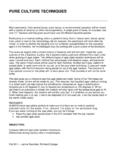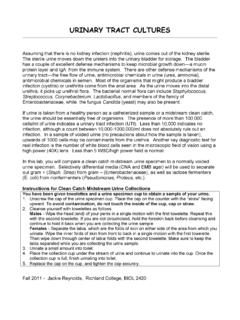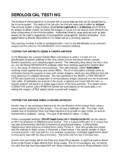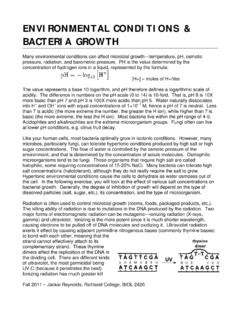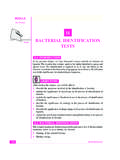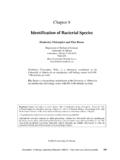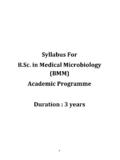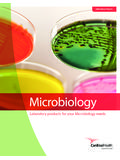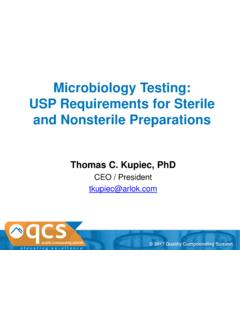Transcription of API 20E - Dallas County Community College District
1 API 20 EThis API-20E test strip(from bioMerieux, Inc.)is used to identify the entericgramnegative rods (although API makes a variety of other test strips for yeast, Staph,anaerobes, etc.) 20 separate test compartments are on the strip, all dehydrated. Abacterial suspension is used to rehydrate each of the wells. Some of the wells will havecolor changes due to pH differences: others produce end products that have to beidentified with reagents. A profile number is determined from the sequence of + and-test results, then looked up in a codebook having a correlation between numbers andbacterial :Learn how to perform and interpret the miniaturized, multi-test technique for NEEDED:agar plates of bacterial NaCl solutions (5ml)sterile Pasteur pipettes + bulbssterile mineral oilAPI 20E test strip (for oxidase-gram negative rods)API test strip incubation chamber AFTERINCUBATION:10% FeCl3, Barrett's reagentsA and B, Kovac's reagentPROCEDURE.
2 Prepare a suspension of the bacteria in the saline a large colony (2-3mm diameter)of the bacterium (a youngpureculture) into the NaCl that the suspension is homogenous and without clumps of the API the strip at a slight angle up from the table top, you willnow inoculate the bacterialsuspension into each well with thesterile the end of the pipette to the side of thecupule, allowingcapillary action to draw the fluid into the well as you slowlysqueeze the bulb. This should eliminate any bubbles forming inthe wells. Each well should be filled up to the neck (seediagram).
3 , VP, and GEL have boxes around their names. Thesetestwells will be filledall the way up to the top of the , ODC, ADH, H2S, and URE are filled asdescribed in step B, but they willthen be filled up to thetop with sterile mineral the strip in its bottom of the incubation chamber has smallindented wells in the bottom: fill it with water justenough to fill these indentations(about 5ml). the strip into this bottom. There should not beso much water that it slops onto the API the top of the incubation chamber over thebottom, and label the strip at 37oC for 18-24 the proper reagents to the compartments:o1 drop of Kovac's to the IND (read within a couple of minutes)o1 drop of Barritt's A and B to VP (a + reaction may take up to 10 minutes)o1 drop of FeCl3 to all other tests as described(chart below)without results on the diagram handed out to you in lab (1, 2, or 4 points for +reaction, 0 points for-reaction).
4 The oxidase test reaction should be negative,and is added as the last test test reactions are added together at a time to give a 7-digit number, whichcan then be looked up in the tests such as motility, growth on MacConkey agar,nitrate reduction and O-F glucose can increase the chances ofa good identification. Your instructor may have you run ormay not. The basic tests are really all that are absolutelynecessary for an identification.(pictures from the api 20e documentation, from BioMerieux)READING THE API 20 TESTSSUBSTRATEREACTION TESTED-RESULTS+RESULTSONPGONPG beta-galactosidasecolorlessyellowADHargi ninearginine dihydrolaseyellowred/orangeLDClysinelysi ne decarboxylaseyellowred/orangeODCornithin eornithine decarboxylaseyellowred/orangeCITcitratec itrateutilizationpale green/yellowblue-green/blueH2 SNa thiosulfateH2S productioncolorless/grayblack depositUREureaurea hydrolysisyellowred/orangeTDAtryptophand eaminaseyellowbrown-redINDtryptophanindo le productionyellowred (2 min.)
5 VPNa pyruvateacetoin productioncolorlesspink/red (10 min.)GELcharcoal gelatingelatinaseno diffusion of blackblack diffuseGLUglucosefermentation/oxidationb lue/blue-greenyellowMANmannitolfermentat ion/oxidationblue/blue-greenyellowINOino sitolfermentation/oxidationblue/blue-gre enyellowSORsorbitolfermentation/oxidatio nblue/blue-greenyellowRHArhamnoseferment ation/oxidationblue/blue-greenyellowSACs ucrosefermentation/oxidationblue/blue-gr eenyellowMELmelibiosefermentation/oxidat ionblue/blue-greenyellowAMYamygdalinferm entation/oxidationblue/blue-greenyellowA RAarabinosefermentation/oxidationblue/bl ue-greenyellowOXoxidaseoxidasecolorless/ yellowvioletLABORATORY REPORT SHEETQUESTIONS:1.
6 What is the purpose of the water in the tray?2. What is the function of the mineral oil?3. What are the advantages of this test (compared to regular biochemical tube media)?4. What are the disadvantages of this test?Revised3/2015,Jackie Reynolds,Richland Colleg


